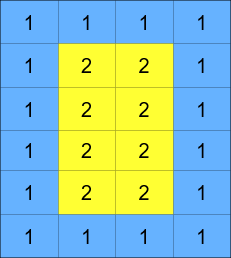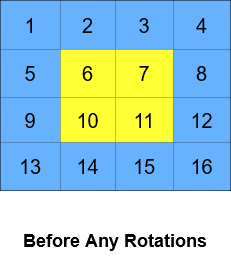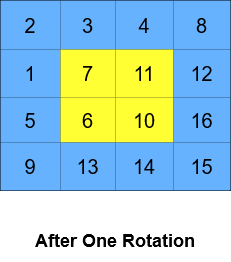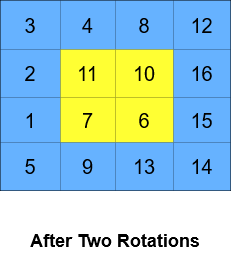LeetCode-in-Java
1914. Cyclically Rotating a Grid
Medium
You are given an m x n integer matrix grid, where m and n are both even integers, and an integer k.
The matrix is composed of several layers, which is shown in the below image, where each color is its own layer:

A cyclic rotation of the matrix is done by cyclically rotating each layer in the matrix. To cyclically rotate a layer once, each element in the layer will take the place of the adjacent element in the counter-clockwise direction. An example rotation is shown below:

Return the matrix after applying k cyclic rotations to it.
Example 1:

Input: grid = [[40,10],[30,20]], k = 1
Output: [[10,20],[40,30]]
Explanation: The figures above represent the grid at every state.
Example 2:



Input: grid = [[1,2,3,4],[5,6,7,8],[9,10,11,12],[13,14,15,16]], k = 2
Output: [[3,4,8,12],[2,11,10,16],[1,7,6,15],[5,9,13,14]]
Explanation: The figures above represent the grid at every state.
Constraints:
m == grid.lengthn == grid[i].length2 <= m, n <= 50- Both
mandnare even integers. 1 <= grid[i][j] <= 50001 <= k <= 109
Solution
public class Solution {
public int[][] rotateGrid(int[][] grid, int k) {
rotateInternal(grid, 0, grid[0].length - 1, 0, grid.length - 1, k);
return grid;
}
private void rotateInternal(int[][] grid, int left, int right, int up, int bottom, int k) {
if (left > right || up > bottom) {
return;
}
int loopLen = (right - left + 1) * 2 + (bottom - up + 1) * 2 - 4;
int realK = k % loopLen;
if (realK != 0) {
rotateLayer(grid, left, right, up, bottom, realK);
}
rotateInternal(grid, left + 1, right - 1, up + 1, bottom - 1, k);
}
private void rotateLayer(int[][] grid, int left, int right, int up, int bottom, int k) {
int[] startPoint = new int[] {up, left};
int loopLen = (right - left + 1) * 2 + (bottom - up + 1) * 2 - 4;
int[] arr = new int[loopLen];
int idx = 0;
int[] currPoint = startPoint;
int[] startPointAfterRotation = null;
while (idx < arr.length) {
arr[idx] = grid[currPoint[0]][currPoint[1]];
idx++;
currPoint = getNextPosCC(left, right, up, bottom, currPoint);
if (idx == k) {
startPointAfterRotation = currPoint;
}
}
idx = 0;
currPoint = startPointAfterRotation;
if (currPoint != null) {
while (idx < arr.length) {
grid[currPoint[0]][currPoint[1]] = arr[idx];
idx++;
currPoint = getNextPosCC(left, right, up, bottom, currPoint);
}
}
}
private int[] getNextPosCC(int left, int right, int up, int bottom, int[] curr) {
int x = curr[0];
int y = curr[1];
if (x == up && y > left) {
return new int[] {x, y - 1};
} else if (y == left && x < bottom) {
return new int[] {x + 1, y};
} else if (x == bottom && y < right) {
return new int[] {x, y + 1};
} else {
return new int[] {x - 1, y};
}
}
}

